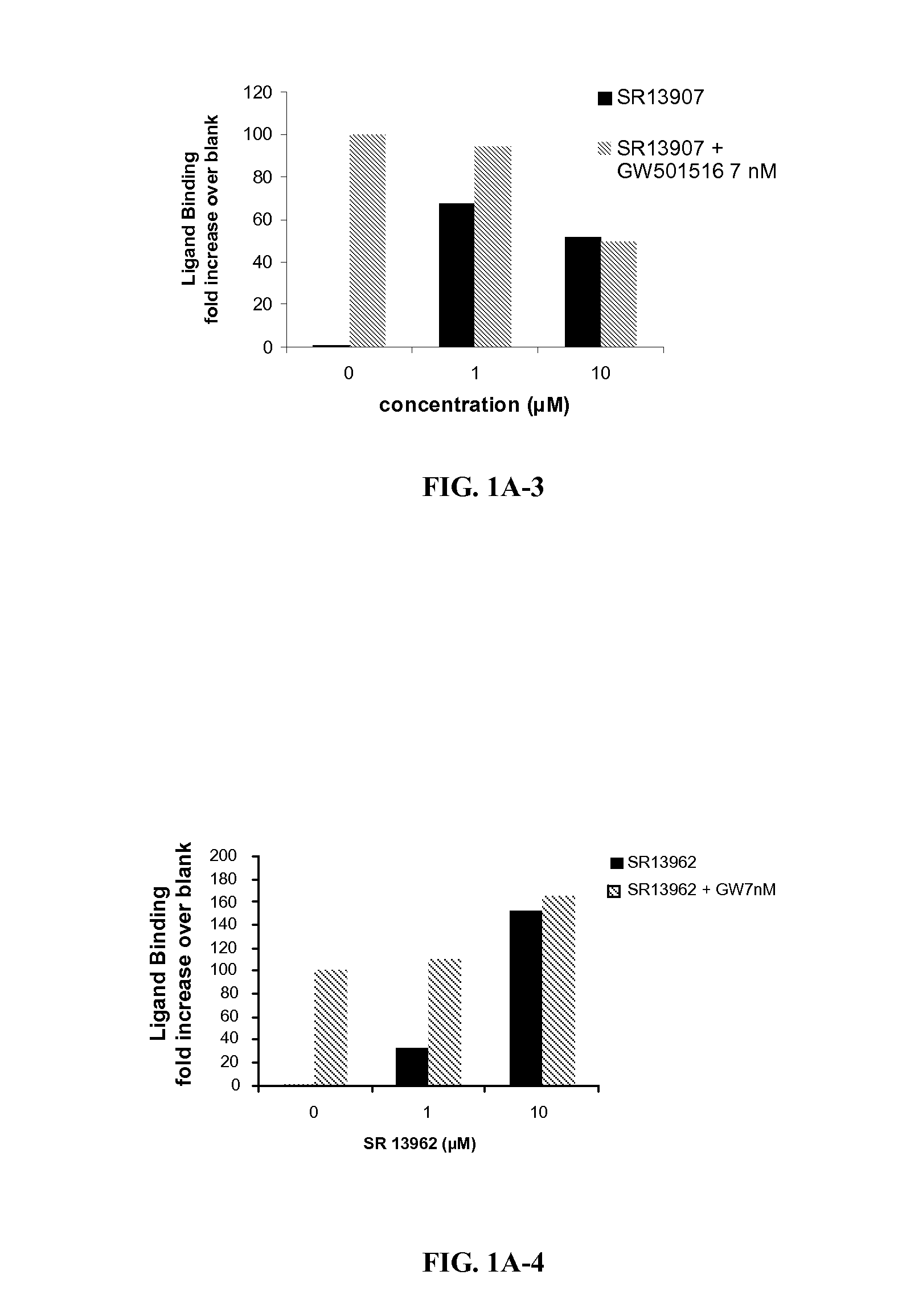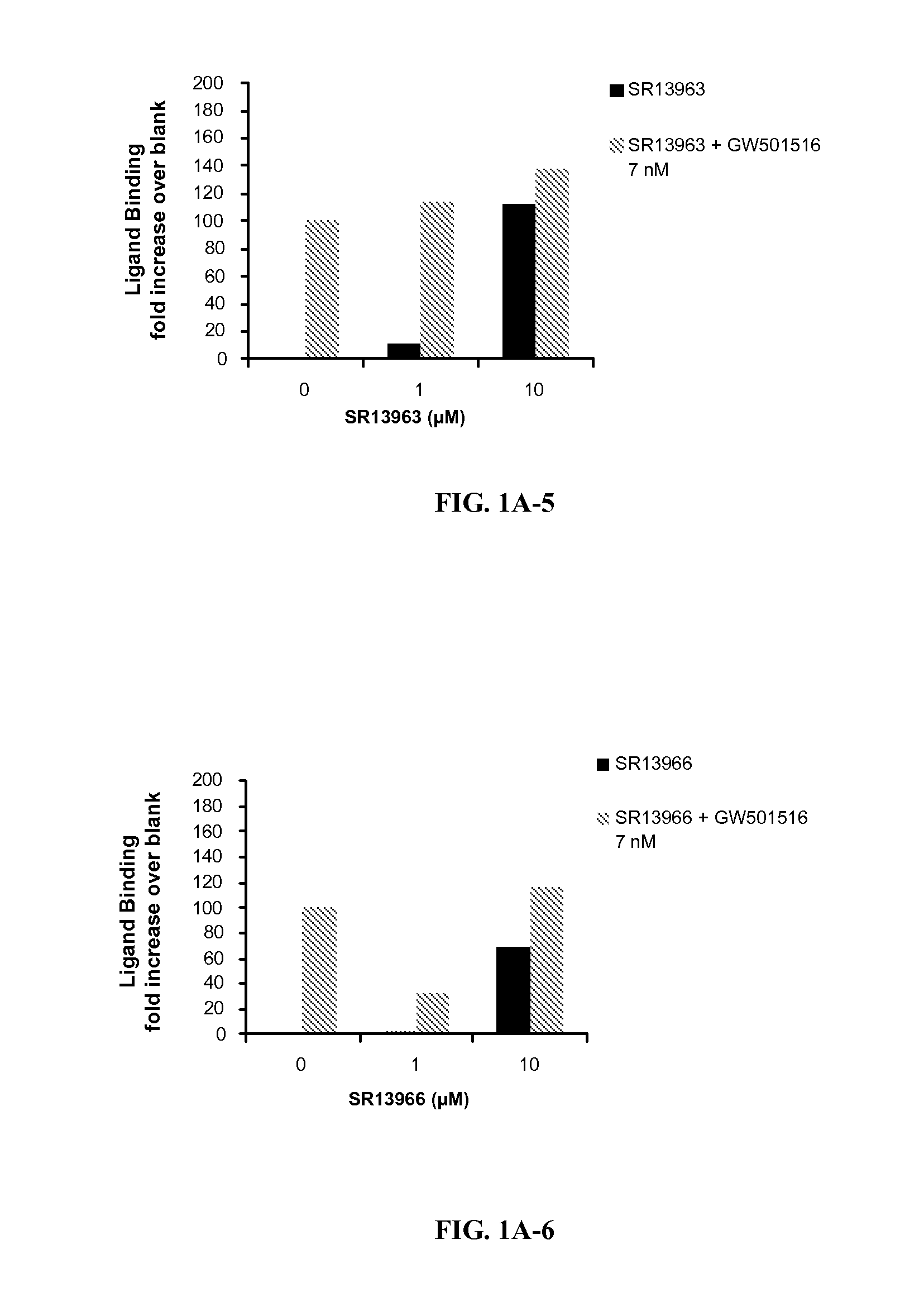Ppar-delta ligands and methods of their use
- Summary
- Abstract
- Description
- Claims
- Application Information
AI Technical Summary
Problems solved by technology
Method used
Image
Examples
example 1
Synthetic Procedures and Example Compounds
[0159]The compounds shown in Table 1 were prepared as representative examples of the compounds described herein. Synthetic procedures for the preparation of some of the compounds are shown below. Any of the compounds of the invention may be prepared using appropriate variations of the synthetic procedures described herein; the scope and nature of such variations will be apparent to the skilled artisan.
TABLE 1Representative example compoundsID NumberStructureSR 13174SR 13175SR 13901SR 13902SR 13903SR 13904SR 13905SR 13906SR 13907SR 13908SR 13909SR 13910SR 13961SR 13962SR 13963SR 13964SR 13965SR 13966
[0160]Synthesis of PPARδ Ligands SR13904, SR13906.
[0161]Scheme 1 shows the step-wise synthetic procedure used to prepare SR13904 and SR13906.
[0162]Preparation of 2.
[0163]A 1000 mL-RB flask was charged with 2-methylphenol (1) (21.6 g), ethyl bromoacetate (25 mL), Cs2CO3 (134 g), and MeCN (500 mL). The mixture was stirred overnight, followed by filt...
example 2
Activity of Selected Ligands
[0198]FIG. 1 shows PPARδ antagonist activity of selected ligands of the invention. SR 13904 binds to the LBD of PPARδ, at concentrations in the low micromolar range (1-10 μM), effectively attenuating LBD binding of GW501 (7 nM). This competition of SR 13904 with GW501 was reflected in significantly reduced Gal-4-controlled UAS-tk luciferase activities when cells were treated with both ligands as compared to GW 501 alone. The transactivation assay confirmed this antagonist behavior of SR 13904 toward PPARδ agonists. Both levels (1 and 10 μM) of SR 13904 completely eliminated the transcription activation of the PPRE reporter to GW501.
[0199]SR 13904 was also shown to interfere with ciglitazone binding to PPARγ LBD and transactivation (data not shown). Based on the cellular and molecular data generated, treatment of prostate cancer cells with SR 13904 attenuates a number of pro-tumorigenic activities that are likely to be associated with PPARδ. Furthermore, t...
example 3
In vitro Evaluation of PPARδ Antagonists
[0201]Referring now to FIG. 2, PPARd expression in tumor cell lines was studied. Cultures of A549, Huh7, MCF-7, and PC-3 lines were grown to near confluency (70-80%), lysed, total cellular protein extracted, blotted, and probed for PPARd and GAPDH (control) proteins. The A549 cultures were grown at two densities: the A549-a lane represents the NSCLC line harvested at 70-80% confluency and A549-b at postconfluent growth.
[0202]SR13904 attenuates proliferation and colony formation of human cancer cells. Lung (A549), liver (Huh7), prostate (PC-3), and breast (MCF-7) carcinomas were selected to determine the effect of SR13904 on proliferation and colony formation. Western blotting showed that all four-cell lines express significant levels of the PPARδ protein (FIG. 2).
[0203]The effect of SR13904 on the proliferation of these cell lines was determined by an Alamar Blue assay. Exponentially growing cells were treated with a range of SR13904 concentra...
PUM
| Property | Measurement | Unit |
|---|---|---|
| concentration | aaaaa | aaaaa |
| structure | aaaaa | aaaaa |
| composition | aaaaa | aaaaa |
Abstract
Description
Claims
Application Information
 Login to View More
Login to View More - R&D
- Intellectual Property
- Life Sciences
- Materials
- Tech Scout
- Unparalleled Data Quality
- Higher Quality Content
- 60% Fewer Hallucinations
Browse by: Latest US Patents, China's latest patents, Technical Efficacy Thesaurus, Application Domain, Technology Topic, Popular Technical Reports.
© 2025 PatSnap. All rights reserved.Legal|Privacy policy|Modern Slavery Act Transparency Statement|Sitemap|About US| Contact US: help@patsnap.com



